If you're reading this, good. You're probably on the most important section of this website - coral reef conservation. Why? Because when you visit Redang, you are visiting the coral reefs around it.
Wait! Don't click away from this page yet!
It's the whole reason why this website exists. We're promoting responsible tourism in Redang in an effort to protect and conserve the coral reefs and marine environment found there. Really, you shouldn't visit Redang unless you understand a little about what you're visiting and why it's important to protect it. So be patient, and read on. You might actually learn something...
The disappearance of coral reefs is of great concern because many people depend on them economically. As many as 500 million people around the world have some dependence on reefs either as a source of food or as a source of additional income. Of these, about 30 million are almost totally dependent on coral reefs for their survival.
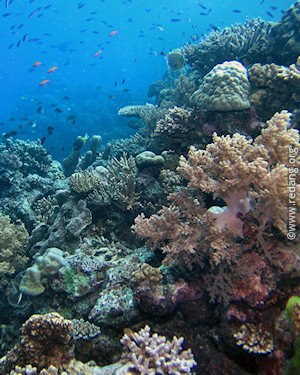
This is a healthy coral reef in Layang Layang. It's fully covered with many species of corals with hardly any empty space in between.
Many fishes that we eat like groupers and wrasses live in coral reefs. Although reefs cover less than 1% of the world's oceans, reefs sustain one-quarter of all known marine life: over 4000 fish species, 700 species of coral and many other plants and animals. Coral reefs are like tropical rainforests in terms of their biodiversity, except reefs are disappearing at twice the rate, which doesn't bode well for reef fish species and their populations.
Reefs provide a means of income and revenue for those in the fishing and tourism industry, including resorts, travel agents, transport operators and shopkeepers. Many countries with healthy reefs attract recreational visitors from all over the world who visit to snorkel and dive and enjoy the marine life.
Coral reefs protect coastal communities from storms by acting as a buffer to minimize the destructive forces of waves and saving many lives and properties. They prevent coastlines from erosion and provide sand for beaches. They are part of an ocean ecosystem that helps to stabilize our climate, create rain for crops and oxygen in the air.
Scientists are also beginning to derive new medicines from reef species for a wide range of illnesses, including heart disease and HIV. Certain coral skeletons are being used in reconstructive bone surgery as they resemble human bone. As with the rainforests, there is still much to explore and discover and it is possible that future cures for certain diseases may come from biochemical extracts of coral reef species. One day, you and I may owe our lives to medicines derived from coral reefs!
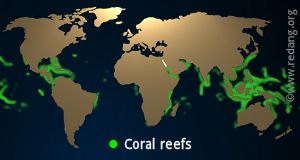
Worldwide distribution of coral reefs.
According to a report published in 2011 by the World Resources Institute titled "Reefs at Risk: Revisited", local human activities threatened more than 60% of the world's coral reefs. Overfishing and destructive fishing were highlighted as the most pervasive human threats which affected more than 55% of the world's reefs while coastal development and watershed-based pollution each affected about 25% of reefs.
The report also noted that the percentage of reefs under threat rose to approximately 75% when these human threats were combined with natural threats such as thermal stress from changes in global climate and rising ocean acidity. Southeast Asian reefs faced the most severe threat while those in Australia the least. It also noted that though a quarter of the world’s coral reefs were within protected areas, most were ineffective or only offered partial protection.
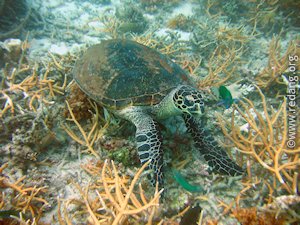
An unhealthy coral reef in Redang that is sparsely covered by a few fast-growing coral species (mainly staghorn) and broken coral littering the seabed.
A separate report, published in 2008 by the Global Coral Reef Monitoring Network (GCRMN) and titled "Status of coral reefs of the world: 2008 (ed. Clive Wilkinson)", noted that up to 35% of the world's existing reefs might be lost in the next 20-40 years mainly due to overfishing, pollution and global climate change. Global warming was seen to be the single biggest threat to reefs worldwide, causing rising ocean temperatures, increasing ocean acidification and bringing a higher frequency of intense tropical storms. Widespread coral bleaching occurred in 1998 and 2010 when ocean temperatures rose substantially, causing many corals to die.
- GCRMN report summary:
- Since 1950, 19% of the world's coral reefs have been destroyed
(>=90% coral loss and unlikely to recover) - 15% of existing coral reefs are in a critical state
(50-90% coral loss and possibly destroyed in 10-20 years) - 20% are seriously threatened
(20-50% loss, possibly destroyed in 20-40 years) - 46% are considered healthy and not under immediate threat of destruction except for currently unpredictable global climate threats
 How you can help to protect coral reefs
How you can help to protect coral reefs
- Be a responsible visitor. When you visit coral reefs, avoid contact with corals, snorkel and dive responsibly and keep the land, beaches and oceans clean.
- Support resorts, tour operators and organizations that operate in an eco-friendly manner and help to protect coral reefs.
- If you operate boats, don't anchor on the reef. Use installed buoys instead.
- Conserve water. The less you use, the less runoff and wastewater will pollute our oceans. Standards of wastewater treatment and management vary greatly and all wastewater, treated or not, eventually reaches our oceans.
- Use eco-friendly products like biodegradable sunscreens when you're at the beach and organic fertilizers in your gardens and lawns. This minimizes harmful chemicals and pesticides from flowing into drains, rivers, and eventually into our oceans.
- Plant trees and use energy-efficient or energy-saving products to reduce your carbon footprint. This will help reduce global warming and rising ocean temperatures.
- Support sustainable fisheries. When eating seafood, choose species that are abundant, well-managed and caught or farmed in environmentally friendly ways. For those living in the US, Monterey Bay Aquarium has a Seafood Watch guide to help you choose ocean-friendly seafood.
Corals are made up of tiny animals called polyps
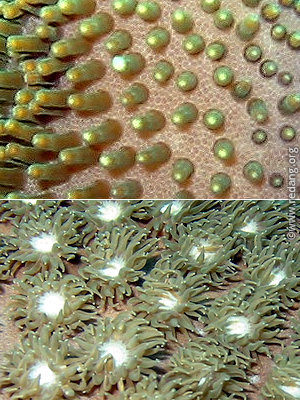
Leather coral polyps with retracted tentacles (top) and with tentacles extended.
While they may look like hard rocks or soft plants, corals are actually colonies of tiny animals called polyps. The size of an individual polyp can be less than a millimeter to as large as 25cm across in a mushroom coral. A polyp is a simple animal comprising tentacles that surround a mouth and a gut. Soft coral polyps have eight tentacles (or multiples of 8) while hard coral polyps have six tentacles (or multiples of 6).
Polyps belong to a group of animals known as cnidarians which literally means 'stinging creatures'. Jellyfish, sea anemones and hydroids are also cnidarians. Some cnidarians like jellyfish float about freely (these are known as the medusa form) while others like coral polyps remain fixed in one place (these are known as the polypoid form). You can think of a coral polyp as a fixed, upside-down jellyfish or a jellyfish as a floating upside-down polyp! In fact, jellyfish spend their early life as polyps which later bud off as free floating tiny juvenile jellyfish.
All cnidarians possess stinging cells called cnidocytes, each of which contain a coiled thread-like harpoon known as a nematocyst. When fired, the nematocyst uncoils and straightens out, piercing through the cell wall and into the skin of the prey. Often, the nematocyst contains a toxin to disable the prey. Polyps use tentacles covered with these stinging cells to catch and feed on plankton brought in by currents. Many coral polyps are not harmful to humans as the nematocyst is either unable to pierce human skin or the toxin is too mild to have any effect. However, stinging hydroids and jellyfish can inflict painful stings and in a few species, the toxin is powerful enough to harm humans.
Coral species can be male, female or hermaphrodite (have both male and female reproductive organs). As coral polyps cannot move around, to reproduce, the entire coral community engages in a mass synchronized spawning event once or twice a year, releasing eggs and sperm at exactly the same time, one species after another. The entire event releases so many eggs into the sea simultaneously that despite many being eaten by fish, many others survive and are carried away by currents. These eggs are sometimes visible as a coloured slick on the water's surface. Fertilized eggs become swimming larvae known as planula. When coral larvae settle on the reef, each one metamorphosizes into a single polyp and begins its own colony under the right conditions. Like cell division, a single polyp can subdivide into two polyps which in turn subdivides into four, then eight and so on. Whole colonies of polyps can be genetically alike, coming from just a single polyp.
Corals need sunlight to live
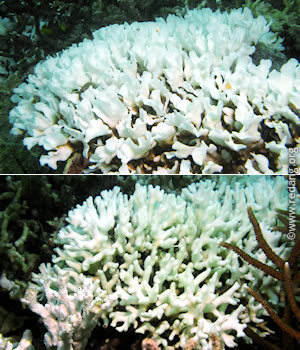
Bleached hard corals appear white.
Coral reefs are found in shallow water because they need sunlight to live. Coral polyps contain algae inside their tissues called zooxanthellae. Algae are plants and require sunlight to convert carbon dioxide and water into simple sugars (food) and oxygen through the process of photosynthesis. Polyps are animals and require oxygen and food for respiration, producing energy and carbon dioxide as by-products.
The algae supplies the polyp with oxygen and shares its food with the polyp. It is estimated that polyps can absorb up to 98% of the sugars produced by the algae. The algae helps the polyp to extract nutrients such as nitrogen from the sea and increases the rate at which hard-coral polyps secrete corallite to build the reef. In return, the algae gets physical protection, nutrients and carbon dioxide from its polyp host. Like good friends helping each other, both the polyp and the algae live in a mutually beneficial relationship known as a symbiotic relationship.
Coral polyps are transparent to allow sunlight to reach the algae. It is the algae present in the polyps that give corals their colour. Certain stressful conditions, such as when ocean temperatures rise or when the acidity of the oceans increase, can induce the coral polyp to expel the algae and thus lose its colour. When this happens, the coral appears white (bleached) because its white limestone skeleton shows through instead. For this reason, dead corals also appear white. If a bleached coral survives, it can be recolonized by the same or different species of zooxanthellae. Different types of zooxanthellae living in polyp tissue have different levels of resistance to bleaching while different species of coral also have different abilities to handle stress and bleaching and how well they recover from bleaching.
Coral reefs are built by hard coral polyps
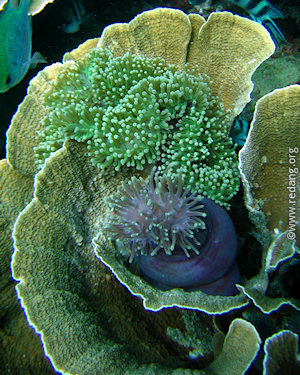
Reefs are built by hard corals such as the lettuce coral shown here. Soft corals like the anemone growing inside the lettuce coral do not build reefs.
Only hard coral polyps build coral reefs. They do this by secreting a hard calcium carbonate limestone skeleton called corallite under and around themselves as they grow. The corallite forms the base for the polyp colony to grow and multiply and also provide protection for the polyps. They are helped by other organisms such as coralline algae that also deposit a layer of calcium carbonate called thallusonto rocky substrates, on top of which the algal plant tissue sits. The thallus acts like a kind of glue, providing structural integrity to the reef and also attracts coral larvae which settle on them and develop into colonies of coral polyps, each secreting corallite and contributing to the building of the reef. As polyps die, their limestone skeleton remains and new polyps take their place, building on top of these skeletal remains. Little by little, over many years, the reef grows in size.
Over time, as different hard coral species multiply and spread out, creating large fields of staghorns, table corals, lettuce coral, ridge coral and other types of hard coral, the coral reef takes shape. These stony corals look like lifeless rocks because the tentacles of the polyps are often retracted away from view. As night falls, many polyps extend their tentacles to feed on zooplankton. Under the cover of darkness, polyps may fight for space with polyps from neighbouring corals, extending their gut over them and digesting them alive.
Soft coral polyps do not secrete external corallite skeletons like hard coral polyps and so do not build reefs. They produce calcium carbonate internally which helps them keep their shape. When soft corals die, they decompose, leaving nothing behind.
Coral reefs take a long, long time to form
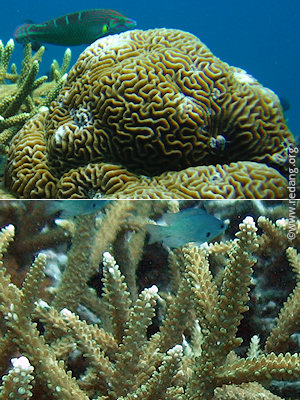
Brain coral (top) grows slowly while staghorn corals grow quickly.
As polyps die and new polyps grow over them, more and more corallite is deposited and the reef grows. This process is slow and many large coral reefs are formed over thousands of years. The rate of growth depends on the species of coral, water temperature, oxygen level, salinity, turbidity, and availability of space and food around them.
Staghorn corals can grow at a rate of up to 20cm each year, while massive boulder corals like brain corals and ridge corals grow only 5 to 25mm per year. This slow growth rate means that reefs are not able to regenerate quickly enough when subjected to high rates of destruction.
Under normal conditions, reefs are quite resilient and can recover from destruction caused by storms, disease and natural predation. For example, many of the reefs affected by the 2004 Indian Ocean earthquake and tsunamis have shown good recovery. However, their recovery is often hampered or reversed by human-induced threats such as pollution (littering and discharge of industrial and organic wastes), sedimentation (soil erosion from deforestation) and destruction (stepping and trampling, anchoring, dynamite fishing) which place excessive stress on reefs. For example, vast areas of coral reefs have been wiped out in places where dynamite fishing is prevalent and many countries today have banned such practices.
As it takes just seconds of carelessness to destroy reefs that take years to form, it is important that resorts operating in reef areas do so in an environmentally-friendly manner to prevent their wastes and pollutants from reaching the sea and that visitors behave responsibly by not littering or trampling on corals.
Coral reefs are a metropolis of diverse lifeforms
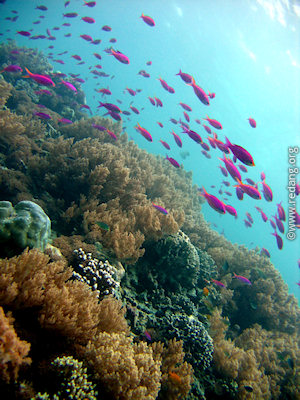
Reefs support a wide diversity of marine life.
Coral reefs provide habitats and protection for a large variety of marine life such as sponges, tubeworms, feather stars, molluscs, crustaceans, starfish, urchins, anemones, jellyfish, fungi, turtles and fish. All of these reef organisms play a part in maintaining the balance of life on the reef.
Many reef animals which feed on algae become food for other predators. Waste products and other sediments that fall to the bottom feed bottom-dwelling scavengers like certain crustaceans and fishes. Some organisms like cleaner shrimp and cleaner wrasse provide cleaning services for other reef life, while others live in symbiotic relationships with other organisms. The coral reef is a remarkable place where everything is recycled and nothing is wasted.
With such a great biodiversity of life dependent on the living reef and on one another for survival, when corals die or when the fish population is drastically reduced through overfishing or removal of certain species of fish, the entire chain and balance of life on the reef is affected. Grazing fish like parrotfish keep algae at acceptable levels and when these fish are removed, the fast-growing algae grows over the slow-growing coral, causing large areas of reef to be covered with seaweed and fleshy algae. When corals die from pollution or climate change, organisms that rely on them for food and shelter disappear and in turn, cause the fishes and other organisms that feed on them to disappear, with a corresponding domino-like effect on other members higher up in the food chain. Recent scientific research has shown that when top predators of the reef like sharks are specifically overfished and killed for their fins, the carnivorous fishes the sharks feed on like groupers multiply and end up greatly reducing the number of grazers and smaller fishes that they in turn feed on, causing algae to bloom unchecked and lead to the decline of coral reefs.
Natural threats
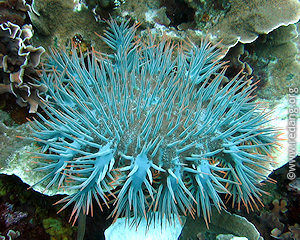
Crown of thorns starfish.
Storms and monsoons bring about powerful wave action that can damage corals and churn up the seabed causing sedimentation, which block sunlight needed by the zooxanthellae.
Diseases that affect the coral polyps and coralline algae can kill them. These may be caused by infectious parasites like bacteria, virus and fungi, or due to non-infectious causes like poor nutrition and exposure to certain environmental conditions.
Predation by reef animals usually do not cause widespread damage unless there is an outbreak in the number of predators. An outbreak of crown of thorns starfish is one of the most damaging. A single starfish can eat as much as 6 square metres of coral a year. A significant increase in their population can decimate entire reefs. The drupella sea snail and nudibranch (a kind of sea slug) also feed on coral polyps, digesting the animal tissue and excreting the zooxanthellae. Sometimes, the nudibranch will also keep the nematocysts and algae for their own use.
Parrotfish also feed on coralline algae on rocks and stony corals. They use their powerful jaws to bite through rock and coral, eroding the coral - one can actually hear them crunching the coral when underwater. These are ground up, ingested and excreted as fine sand. A single parrotfish can produce up to 300 lbs of sand every year! Next time you enjoy the beautiful white sand under your feet, remember you may be stepping on parrotfish poo!
The reef can often recover from such short-term stress and in some cases, these might even benefit the reef due to recolonization of damaged areas by a greater diversity of organisms.
Human threats
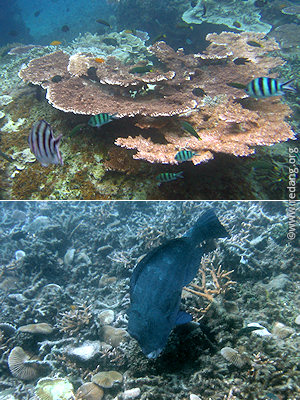
Broken table coral at Marine Park (top) and a bumphead parrotfish feeding in a field of coral rubble.
Global warming has a catastrophic impact on coral reefs. Corals are sensitive to water temperature and will bleach and die when their upper temperature threshold is exceeded. The El Nino phenomenon of 1998 destroyed a high percentage of coral cover globally through mass bleaching and only about 40% of the damaged reefs are recovering well or have recovered. Greenhouse gas emissions arising from human activities in industrialized parts of the world are a major contributor to global warming. Rising temperatures on earth have already resulted in ice shelfs melting and breaking off at the poles and more extreme weather conditions around the world.
Sewage and toxic discharges generated from domestic, agricultural and industrial runoffs containing pesticides and chemicals, and sedimentation from land clearing can cause stress to reefs. Long-term exposure to water containing these contaminants weakens the reef and causes their eventual destruction. Other related ecosystems like mangroves, which provide safe habitat for the young of many marine animals, are also affected by such contaminants. The destruction of mangrove areas worsens the general health of the reef as they, together with mudflats and sea grasses, all belong to the same bigger ecosystem.
Coral reefs are very sensitive to water quality. Too much organic matter and nutrients will create widespread growth of algal blooms that can smother corals, blocking out space and sunlight required for their survival. Too much sediment in the water also has the same effect of blocking sunlight from reaching the corals and smothering the polyps when the sediment settles on them. Without sunlight, the algae present in coral tissue cannot photosynthesize food, and the coral polyps will die. Control measures must therefore include proper treatment of all sewage and wastewater, and proper control of run-off using drains and silt-traps.
Other human threats include coral damage caused by anchoring on coral reefs, coral breakage caused by careless or irresponsible visitors, and coral mining where corals and marine life are collected for sale or export. In many other parts of the world, irresponsible fishing practices using cyanide or explosives have killed large areas of reefs but fortunately, these practices have been banned and outlawed in many countries with coral reefs.
According to a year 2000 study (see footnote 1) of 3 marine parks (Pulau Redang Marine Park, Pulau Tioman Marine Park and Pulau Tinggi Marine Park), the east coast of Peninsular Malaysia has a very high coral and fish species richness and is considered to be a globally important area of coral biodiversity. Specifically, the study at Pulau Redang Marine Park was carried out at Teluk Mat Dollah, Chagar Hutang, Terumbu Kili, Pulau Ling, Pulau Lima and Pulau Lang Tengah.
The coral and fish species identified in this study were almost 80% of the number of species identified in the ‘Coral Triangle’, an area bounded by Papua New Guinea, Indonesia, east Malaysia and the Philippines, which is known to have the greatest coral diversity on earth. The health of the reefs in the surveyed areas were rated as 'fair' to 'good' based on the amount of coral cover (42.2%), the amount of non-coral algal cover (<10%), low percentage of recently-killed coral (5.3%, mostly caused by marine life feeding on corals) and good water visibility (average of 14m). However, there is a lack of previous data to compare with, so long-term data such as the rate of decline of coral cover in Redang has not been clearly established.
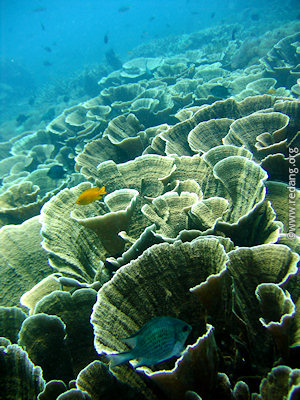
Healthy lettuce coral field in Redang.
Coral reefs at Redang were among the less severely affected during the outbreak of El Nino in 1998 and 2005, which wiped out coral reefs in some other parts of the world. Nevertheless, it brought about a reduction in coral cover in Redang. Other threats in Redang were identified as nutrient run-off from sewage/wastewater discharge in some populated areas and sedimentation due to deforestation. Lesser threats included discarded rubbish and refuse, irresponsible diving and snorkelling, mechanical damage due to boat anchors, 'ghost' fishing nets, and reef-eaters such as crown-of-thorns starfish and drupella.
It was noted that in general, many procedures were already in place to protect the marine environment at Redang, such as the ban on fishing within marine park waters, the presence of mooring buoys for boats, observance of park regulations by resort operators and boatmen, and the availability of wastewater treatment facilities at some populated areas.
More recently, in October 2003, a Reef Check (see footnote 2) was organized to collect data about the health of coral reefs in Redang. Volunteer divers conducted checks on six sites around Pasir Panjang. The results showed that coral cover was healthy at the North house reef (56.9%), Mini Mount (57.5%) and Pulau Paku Kecil (54.8%) while the other three sites had fair cover - the South house reef (45%), the deep reef at Pulau Lima (33%) and the shallow reef at Pulau Lima (47.8%). The Reef Check process is an important step in enabling regular monitoring of the health of the reefs in Redang by local resort operators and volunteer organizations. Over time, such quantitative data will paint a more accurate picture of the overall condition and the rate of deterioration of the reefs.
Effective protection begins with the proper formulation and enforcement of environmental policies and regulations (not just those covering resort and village operations but also those that govern the development of Redang), continual long-term monitoring of environmental indicators such as water quality, regular maintenance of equipment and facilities, and most importantly, changing people's mindset and attitudes towards coral reefs. Educating resort staff and visitors about the importance of conservation can help them to be more aware of their actions and to minimize the human impact on the marine environment.
Footnotes:
1: Status Report on the coral reefs of the East Coast of West Malaysia 2000 by Harborne, A., D. Fenner, A. Barnes,
M. Beger, S. Harding and T. Roxburgh. The pdf report is available
from Reefbase.
2: Reef Check is an international program that works with communities,
governments and businesses to scientifically monitor and manage coral reef health.